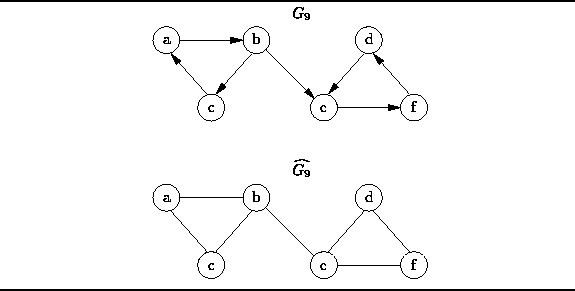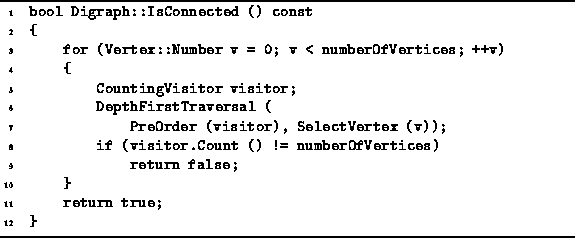When dealing with directed graphs, we define two kinds of connectedness, strong and weak. Strong connectedness of a directed graph is defined as follows:
Definition (Strong Connectedness of a Directed Graph) A directed graphis strongly connected if there is a path in G between every pair of vertices in
.
For example, Figure ![]() shows the directed graph
shows the directed graph
![]() given by
given by
![]()
Notice that the graph ![]() is not connected!
E.g., there is no path from any of the vertices in
is not connected!
E.g., there is no path from any of the vertices in ![]() to any of the vertices in
to any of the vertices in ![]() .
Nevertheless, the graph ``looks'' connected
in the sense that it is not made of up of separate parts
in the way that the graph
.
Nevertheless, the graph ``looks'' connected
in the sense that it is not made of up of separate parts
in the way that the graph ![]() in Figure
in Figure ![]() is.
is.
This idea of ``looking'' connected
is what weak connectedness represents.
To define weak connectedness we need to introduce first
the notion of the undirected graph that underlies a directed graph:
Consider a directed graph ![]() .
The underlying undirected graph is the graph
.
The underlying undirected graph is the graph
![]() where
where
![]() represents the set of undirected edges that is obtained
by removing the arrowheads from the directed edges in G:
represents the set of undirected edges that is obtained
by removing the arrowheads from the directed edges in G:
![]()

Figure: An Weakly Connected Directed Graph and the Underlying Undirected Graph
Weak connectedness of a directed graph is defined with respect to its underlying, undirected graph:
Definition (Weak Connectedness of a Directed Graph) A directed graphis weakly connected if the underlying undirected graph
is connected.
For example,
since the undirected graph ![]() in Figure
in Figure ![]() is connected,
the directed graph
is connected,
the directed graph ![]() is weakly connected.
Consider what happens when we remove the edge (b,e)
from the directed graph
is weakly connected.
Consider what happens when we remove the edge (b,e)
from the directed graph ![]() .
The underlying undirected graph that we get is
.
The underlying undirected graph that we get is ![]() in Figure
in Figure ![]() .
Therefore,
when we remove edge (b,e) from
.
Therefore,
when we remove edge (b,e) from ![]() ,
the graph that remains is neither strongly connected nor weakly connected.
,
the graph that remains is neither strongly connected nor weakly connected.
A traversal of a directed graph (either depth-first or breadth-first)
starting from a given vertex
will only visit all the vertices of an undirected graph
if there is a path from the start vertex to every other vertex.
Therefore,
a simple way to test whether a directed graph is strongly connected
uses ![]() traversals--one starting from each vertex in
traversals--one starting from each vertex in ![]() .
Each time the number of vertices visited is counted.
The graph is strongly connected if all the vertices are visited
in each traversal.
.
Each time the number of vertices visited is counted.
The graph is strongly connected if all the vertices are visited
in each traversal.
Program ![]() shows how this can be implemented.
It shows the IsConnected member function of the Digraph
class which returns the Boolean value true if the graph
is strongly connected.
shows how this can be implemented.
It shows the IsConnected member function of the Digraph
class which returns the Boolean value true if the graph
is strongly connected.

Program: Digraph Class IsConnected Member Function Definition
The routine consists of a loop over all the vertices of the graph.
Each iteration does a DepthFirstTraversal using
the CountingVisitor given in Program ![]() .
The running time for one iteration
is essentially that of the DepthOrderTraversal
since
.
The running time for one iteration
is essentially that of the DepthOrderTraversal
since ![]() for the counting visitor.
Therefore, the worst-case running time for the IsConnected routine
is
for the counting visitor.
Therefore, the worst-case running time for the IsConnected routine
is ![]() when adjacency matrices are used
and
when adjacency matrices are used
and ![]() when adjacency lists are used to represent the graph.
when adjacency lists are used to represent the graph.